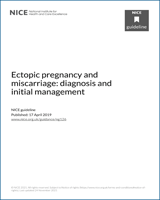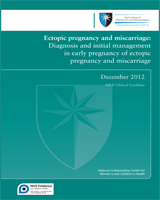Description of included studies
Three studies were included in this review (Hensleigh et al., 1977; Keith & Bozorgi, 1977; Stewart et al., 1978). All of the studies were randomised controlled trials conducted in the USA, and evaluated the administration of different doses of anti-D rhesus prophylaxis to women following first trimester therapeutic abortion. Two studies compared doses of 50 micrograms and 300 micrograms (Keith & Bozorgi, 1977; Stewart et al., 1978). The third study compared three different doses of 73, 155 and 499 micrograms (Hensleigh et al., 1977). No studies were identified that compared different doses following an ectopic pregnancy or miscarriage.
Evidence to recommendations
Relative value placed on the outcomes considered
For the review looking at the provision of anti-D rhesus prophylaxis, the key outcome of interest for the guideline development group (GDG) was the incidence of sensitisation following a miscarriage or therapeutic abortion, as it is this which anti-D rhesus prophylaxis is supposed to prevent. This included both sensitisation in the current pregnancy and sensitisation in subsequent pregnancies.
For the review looking at the appropriate dose, the key outcome was the effectiveness of the prophylaxis at different doses.
Trade-off between clinical benefits and harms
The group recognised that there is little harm associated with the provision of anti-D rhesus prophylaxis. While there is always a potential risk of transferring blood-borne disease when administering blood products, this risk is very low given the screening that is conducted before their use. The group was not aware of any other adverse outcomes associated with the use of anti-D rhesus prophylaxis and there was only one such outcome reported in the available evidence.
By contrast, the group recognised that there is a clear health benefit in avoiding sensitisation if possible. Sensitisation increases the chance of miscarriage in a later pregnancy and also increases the chance that subsequent babies will develop a range of conditions including fetal heart failure, hydrops (fluid retention), oedema, anaemia and rhesus disease. Rhesus disease, in turn, increases the chance of the baby developing kernicterus which can cause brain damage or even death.
Quality of evidence
The group recognised that all of the evidence available for this topic was of very low quality. There were only three studies looking at the use of anti-D rhesus prophylaxis which reported comparative data. None of the studies was very large and it is unlikely that any were sufficiently powered to detect a statistically significant difference. The group had hoped to see evidence in women with a threatened miscarriage and in women with ectopic pregnancy. However, none was available which met the inclusion criteria. All of the studies reported data in women with either a miscarriage (the vast majority of which were managed with surgery) or a therapeutic abortion. There was no evidence for women undergoing medical management of miscarriage and a very small proportion of women had a complete miscarriage without intervention.
For the question of the appropriate dose, again there were only three comparative studies. While one was relatively large, all were of very low quality.
Given the paucity of available evidence, the GDG's recommendations were mainly developed through the members' own clinical experience and that of the clinical adviser for this topic.
Trade-off between net health benefits and resource use
Although the quality of the evidence was very low for the descriptive studies, the group felt that, taken as a whole, there was evidence of a risk of sensitisation for women if they did not receive anti-D rhesus prophylaxis following a first trimester miscarriage or therapeutic abortion. The group recognised that the comparative studies did not show a statistically significant difference in the rate of sensitisation between women who did and did not receive anti-D rhesus prophylaxis. However, the group believed that the small size of the studies meant that this was unlikely to be a true finding of no effect.
The group was informed that the chance of sensitisation increases when there is a greater likelihood of mixing between the maternal and fetal blood. As a result, there is an increased risk of sensitisation when treating a miscarriage or ectopic pregnancy surgically.
Given the lack of evidence, the GDG did not feel it appropriate to recommend that women with a miscarriage or ectopic pregnancy that resolves spontaneously, without intervention, routinely receive anti-D rhesus prophylaxis. However, recognising the increased risk of sensitisation to women undergoing a surgical intervention, the group felt it appropriate to recommend that these women should receive prophylaxis.
The GDG considered the population of women who will receive medical management for their miscarriage or ectopic pregnancy. From the GDG members' clinical experience and understanding, the effect of misoprostol is to cause the body to mimic the physiological changes that occur during a spontaneously completing miscarriage. They felt that the risk of significant maternal and fetal blood mixing during methotrexate treatment for an ectopic pregnancy was likely to be low. Given this, they did not believe that it would lead to an increased risk of sensitisation, and thus agreed that women receiving medical management for either miscarriage or ectopic pregnancy should not be offered prophylaxis.
The evidence available for the review of the appropriate dose suggested that a 50 microgram dose (250 international units) of prophylaxis was as effective as a larger dose. Given this, and the fact that the 50 microgram dose is cheaper, the GDG agreed that this is the dose which should be provided.
Other considerations
The group noted from the evidence that some of the studies reported the use of a Kleihauer test in which the maternal blood is stained to detect the presence of cells containing fetal haemoglobin and the number of these cells is then manually counted. The group received expert advice that the accuracy of the test decreases at low levels of fetal haemoglobin (less than 1 cell in every 10,000). The group noted that at the time of gestation covered in the guideline, the levels of fetal haemoglobin were likely to be very low, and thus the Kleihauer test was unlikely to give an accurate result. This was supported by the data reported in the included studies, which showed low correlation between the Kleihauer test results and risk of sensitisation. Given this, the group agreed that this specific diagnostic test should not be used for this group of women.


